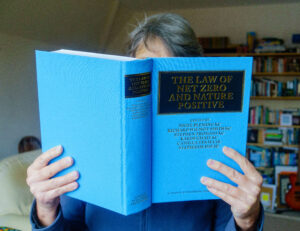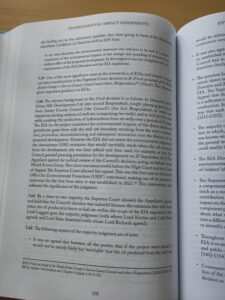 I was pleased to be asked to review The Law of Net Zero and Nature Positive, a new book by barristers at 39 Essex Chambers. I was flattered – but mainly I hoped it would give my knowledge of these important topics a boost.
I was pleased to be asked to review The Law of Net Zero and Nature Positive, a new book by barristers at 39 Essex Chambers. I was flattered – but mainly I hoped it would give my knowledge of these important topics a boost.
Climate litigation is a huge growth area. In the UK and other countries, campaigners are turning to the law out of frustration at the lack of political progress and the failure to enforce laws intended to protect the environment. Nearly three decades of negotiations under the UN Framework Convention on Climate Change have not managed to halt the emission of greenhouse gases. As a result we are shooting through the 1.5 degree warming limit.
Meanwhile, UK rivers, which in theory have good legal protection, are full of sewage and pollution from farms, road run-off and more.
But despite being something of a poster-person for climate litigation since I had the extraordinary good fortune to win a landmark legal victory last year in a case I brought on behalf of the Weald Action Group, I know almost nothing about most aspects of the law.
So I opened the book with interest and some trepidation.
Chapter 1 opens by quoting from a speech by UNEP Executive Director Inger Andersen to the UK Bar Council in 2021: “To members of the judiciary: you are all climate judges now … To barristers and solicitors: you are all climate lawyers now.” It’s clear the editors and authors of this book have taken her message to heart. It’s a diligent survey of the myriad laws and policies affecting climate and nature in England and Wales, and includes summaries of international cases too.

The book begins with introductions to the overarching international and domestic legal frameworks; key environmental principles; and the various regulators and public authorities. Then a further 38 chapters cover commercial and financial services, construction, planning and environmental matters, environmental protest, public international law and fiscal measures.
There’s a huge breadth of content. Just as one example, I was pleased to see that the ‘transition from fossil fuels’ section has ten pages on onshore oil & gas – often overshadowed by offshore.
I hoped the book might give me ideas for possible legal routes for defending the endangered Atlantic Salmon to share with the Friends of the River Exe legal group. But it’s hard to know where to start. There are so many sections dealing with different laws and regulations relevant to rivers and their wildlife. This exercise brought home that anyone considering taking legal action is well advised to talk to lawyers!
Reading about cases I have followed or supported – including ones brought by Friends of the Earth, Transport Action Network and Andrew Boswell – reminded me how much time and effort goes into each of the cases covered. Legal campaigns are very costly in terms of energy, money and time. With cases sometimes running for years (five in our case), it is far too slow a process to deal with the accelerating climate and nature emergencies. Yet it feels like our best shot.
Now the Prime Minister and the Chancellor of the Exchequer want to make it harder for green groups to use the law to challenge development. Last month the Guardian reported Keir Starmer saying: “For too long, blockers have had the upper hand in legal challenges – using our court processes to frustrate growth. We’re putting an end to this challenge culture by taking on the nimbys and a broken system that has slowed down our progress as a nation.” The government wants to stop campaigners bringing “excessive” legal challenges to planning decisions for major infrastructure projects including airports, railways and nuclear power stations.
This makes no sense. There is already a high bar to getting cases heard in the Courts. And the government seems to believe that any infrastructure project is good for the economy – demonstrably untrue in many cases. The best way the government could reduce annoying legal challenges is to plan projects properly and in accordance with relevant laws and policies in the first place.
The excerpt from Inger Andersen’s speech ends: “We cannot safeguard the future of humanity without the right laws and strong enforcement”. We have to stand firm against the government’s growth-at-all-costs agenda and defend our right to recourse to the law. This book should prove a useful resource for campaigners looking to use the law to defend places important for nature, or biodiversity generally, to fight the climate emergency or to defend their own right to protest. At £125 it’s not a snip but I’m sure would prove its worth many times over for environmental NGOs and advice centres.

Finally, I was surprised to find two paintings reproduced at the front of the book. They are by illustrious environmental lawyer and KC Stephen Tromans, who it turns out is a talented artist too. It’s a shame they’re in black and white, but you can see more paintings in their full glory on his website at www.stlaw.co.uk.
- You can buy The Law of Net Zero and Nature Positive at https://londonpublishingpartnership.co.uk/books/the-law-of-net-zero-and-nature-positive/
- I also recommending subscribing to The Wave, a newsletter about climate litigation and climate justice written by journalist Isabella Kaminski.
One thought on “The Law of Net Zero and Nature Positive”